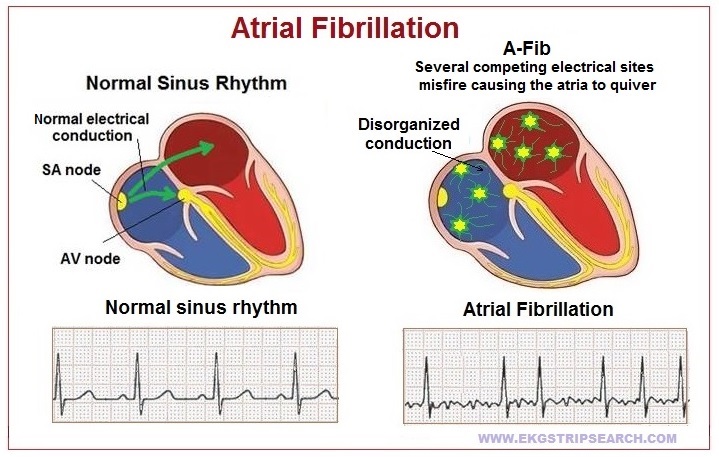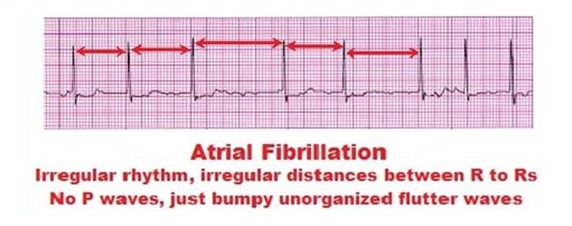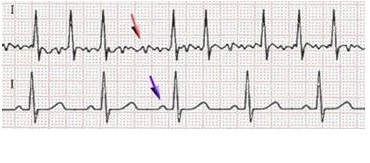
A-fib is the most common type of irregular heart rhythm. The electrical impulses
do not travel in an orderly fashion through the atria as with normal conduction
(sinus rhythm). Instead, in several areas inside the atria form groups of excitable
cells, generate electrical impulses that fire simultaneously and spread throughout
the atria causing a short circuiting effect (see above). These impulses result in a
very rapid and disorganized contraction of the atria which are out of sync with the
ventricle contractions. The rate of impulses firing inside the atria can range from
300 to 600 beats per minute. However, the AV node's safety mechanism limits the number
of impulses it allows to travel through to the ventricles. As a result, the pulse rate
(ventricular rate) is irregular and often less than 150 bpm.
Overall, A-fib is more often fast and can cause symptoms like palpitations, syncope,
shortness of breath and weakness. Because the atria and ventricles are out of sync,
this can cause blood to pool inside the atria (Stasis). This leads to formation of
blood clots (thrombus), which may cause a stroke or pulmonary embolism (PE).

When interpreting A-fib on an EKG strip, the rhythm will be irregular and not have
P waves. With sinus rhythm, the P waves will be in place with equal PR intervals.
With A-fib, you may see small irregular flutter waves (kind of like a bumpy road)
which can sort of resemble P waves. Flutter waves are not like well-developed
P-waves with equal PR intervals, uniform and consistent (see below).
Irregular + no P waves = A-fib

Possible causes of atrial fibrillation
Abnormalities or damage to the heart's structure are the most common cause
of atrial fibrillation. Possible causes of atrial fibrillation include:
- High blood pressure
- Heart attacks
- Coronary artery disease
- Abnormal heart valves
- Heart defects (congenital)
- Overactive thyroid gland or other metabolic imbalance
- Exposure to stimulants, such as medications, caffeine, tobacco or alcohol
- Sick sinus syndrome (improper functioning of the heart's natural pacemaker)
- Lung diseases
- Previous heart surgery
- Viral infections
- Stress due to pneumonia, surgery or other illnesses
- Sleep apnea
If no underlying cause can be found, treatment options are:
- medicines to reduce the risk of a stroke.
- medicines to control atrial fibrillation
- cardioversion (electric shock treatment)
- catheter ablation
- pacemaker insertion
A-fib is often treated with medications to slow the heart rate to a near normal
range (rate control). Cardioversion can also be used to convert A-fib back to a
sinus rhythm and is often used in emergencies if the person is unstable. Ablation
may be done to prevent recurrence in some people. Depending on the risk of stroke,
either aspirin or anti-clotting medications such as warfarin or a novel oral
anticoagulant may be recommended. While these medications reduce this risk, they
increase rates of major bleeding. Other types of medications for treatment may
also be used, for example, beta blockers or calcium channel blockers depending on
status of the patient.
|



